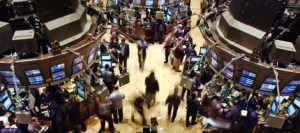
February 10, 2018 | Daily JAM, Friday Trick or Trend |
This week did brought attention to how spectacularly wrong a trading strategy that had bet that the prevailing low volatility continuing had gone wrong. The posture children for the blow up of this strategy was when two exchange-traded funds (ETFs) that bet on lower volatility, VelocityShares Daily Inverse VIX Short-term Futures ETN (XIV) and ProShares Short VIX Short-term Futures (SVXY,) fell about 95%. But the implosion of these two ETFs is just the tip of the low volatility debacle that unfolded this week. And that helped drive volatility in during this correction.

February 9, 2018 | Uncategorized, You Might Have Missed |
Once upon a time, before the U.S. stock market moved into an actual correction and before bond yields spiked, the Federal Reserve was clearly on track to raise short-term interest rates at its March 21 meeting. The debate in the financial markets was about whether the Fed would increase its benchmark interest rate three or four times in 2018. But then we got tax cuts piled on top of spending increases.

February 8, 2018 | Daily JAM, Short Term |
Here we go again. After a pause that raised hopes that the slide in U.S. stocks was over, today the sell off has resumed. As of 3:30 p.m. New York time, the S&P 500 stock index was down 2.59%, or 60.3 points, to 2612.

February 5, 2018 | Daily JAM, Morning Briefing |
The next level in this market that might bring some buyers off the sidelines and slow the plunge in stocks comes at the 200-day moving average near 2538.

February 5, 2018 | Daily JAM, Notes You Need, VIX |
In my daily trawling through the market I come upon lots of tidbits of knowledge that I think are important to investors but that don’t justify a full post. I’ve decided to start compiling these notes here each day in a kind of running mini blog that I’m calling Notes You Need. A representative post resembles this entry from today: “10:40 a.m.: Earlier rumors have advanced to reports of talks between Archer-Daniels-Midland and Bunge (BG) about an acquisition of the latter company. Bloomberg is reporting that the deal could be agreed as early as this week. Soybean giant Bunge is a member of my long-term 50 Stocks Portfolio. The shares are up 4.33% today.”

January 29, 2018 | Daily JAM, Morning Briefing, Short Term, Volatility |
Last week we saw Treasury bond prices fall and their yields rise on weakness in the U.S. dollar. Today the dollar is stronger–up 0.31% on the Dollar Spot Index–but bond prices have still stumbled and yields on the 10-year Treasury have climbed to 2.7%, the highest level since early 2014.
What seems to be driving this dynamic is fear in the bond markets of end of the week data on the jobs market.

January 16, 2018 | Daily JAM, Short Term, Volatility |
U.S. stocks came racing out of the gates on strength in overseas markets with the Dow Jones Industrial Average trading at 26,000–283 points higher than the Friday close at one point during the day. Then came the plunge. As indexes gave back all their gains and then some. The Dow closed 10.3 points lower at 25,793. The Standard & Poor’s 500 traded above 2,800 for the first time and then fell to close down 0.4% for the day. The NASDAQ Composite also finished lower on the day. This kind of intraday reversal is never a sign of market health.

December 27, 2017 | Daily JAM, Mid Term, Volatility, You Might Have Missed |
Black swan events in the financial markets are terrifying. By definition they’re extremely rare and extremely difficult to predict. Which wouldn’t be so scary if their effects weren’t so catastrophic. A 10% drop in the Standard & Poor’s 500 would certainly be painful–but it doesn’t rise to the category of a black swan. Neither does a 15% drop in the price of Bitcoins. Or a 20% drop in the price of Apple (AAPL). All these are relatively normal negative events. They’ve happened before. They happen relatively frequently. And in some cases–that of Bitcoin or the S&P 500, for example–they’re absolutely statistically normal for the market or a part of the market or a specific asset. No, the label “black swan’ is reserved for things like the 2008 global financial crisis that almost brought the world’s financial markets and its real economies to their knees. Or the Dot.com crash of 2000, which saw corporate giants such as Nortel Networks disappear from the economic landscape. Or the oil price crash of 2008 that saw oil soar to a high of $147 a barrel in July and then plunge to $32 by December. Given how devastating to a portfolio a black swan event can be, it seems, at first, surprising that most lists of “bad things that could happen in the year ahead” pretty much ignore this type of financial event.

December 4, 2017 | Daily JAM, Morning Briefing, Short Term |
Let’s just say that today’s action in the U.S. stock market raised my worry quotient significantly. I’m still not looking for a major sell off but it significant (further) damage to momentum stocks and risk-on sectors? Yeah that looks probable. Two things–the two things in the headline to this post–created most of my worry today as I look back on the session.

December 3, 2017 | Daily JAM, Friday Trick or Trend, Short Term, Volatility, You Might Have Missed |
Lot of action last week worth paying attention to. But not a lot of clarity, yet, on what all the action meant. It’s too early to say that last week was a pivotal week for the market but it’s sure time to start thinking about the possibility. The Standard & Poor’s 500 saw a huge surge. In the options market the implied volatility for the index began the week at plus/minus $21, Don Kaufman of Theo Trade noted this weekend. The move for the week turned out to be twice that at $42. At the same time the NASDAQ, and especially the big tech stars of the recent market–Amazon, Alphabet, Google, etc.–broke to the downside. The financial and energy sectors moved up on the week by more than enough to offset the drop in technology, however.

November 18, 2017 | Daily JAM, Friday Trick or Trend |
The problem for the market isn’t that there are signs of a big move to the downside. Instead it’s the absence of clear signs about either direction at all that has the market worried–especially as we head into a short holiday week with really only two full days of trading.

November 5, 2017 | Daily JAM, Short Term |
The combination of a president who frequently goes off script with a deeply paranoid regime in North Korea is very likely to generate language (and let’s hope that’s all it is) capable to producing big one- or two-day moves in financial markets. It doesn’t help that the U.S. delegation has been stripped of some senior voices. Treasury Secretary Steve Mnuchin and White House economic advisor Gary Cohn will both stay home in Washington to lobby Congress for Trump’s positions in the tax cuts moving to mark-up in the House on Monday.













